Comprehensive Report: Managing People in Facilities Management
VerifiedAdded on 2023/01/10
|28
|10458
|69
Report
AI Summary
This report analyzes the management of people within a facilities management context, using Knight Frank as a case study. It explores various approaches to workload planning and work allocation, evaluating their effectiveness in achieving organizational goals. The report delves into recruitment processes, selection criteria, and identifies strengths and weaknesses, offering recommendations for improvement. It examines strategies for motivating and retaining staff, including the application of relevant theories and reward systems. Furthermore, it analyzes staff development, succession planning, and the impact of disciplinary and grievance procedures. The report also covers performance appraisal, communication methods, stress management, and the implications of employment legislation, providing a comprehensive overview of people management within facilities management.
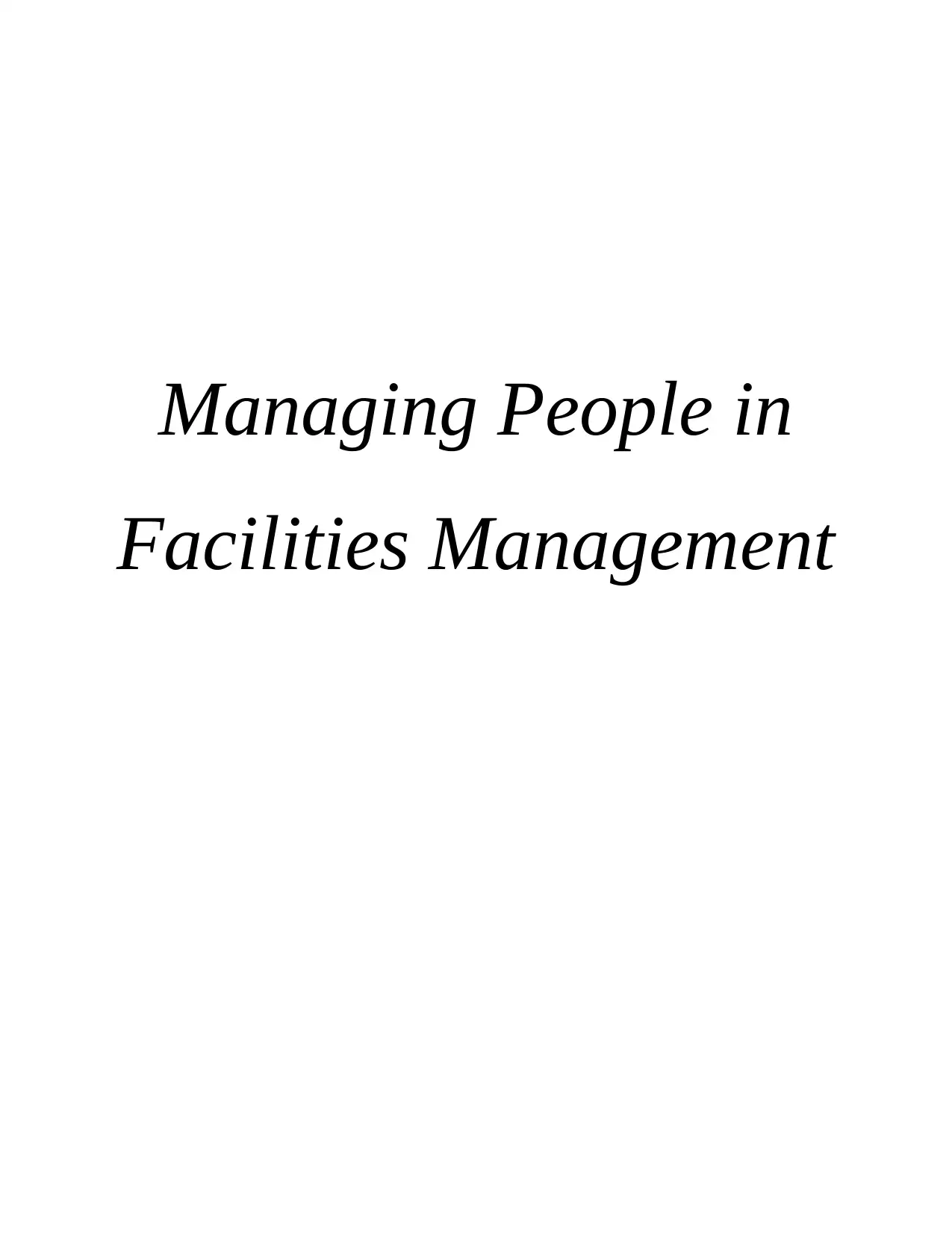
Managing People in
Facilities Management
Facilities Management
Paraphrase This Document
Need a fresh take? Get an instant paraphrase of this document with our AI Paraphraser
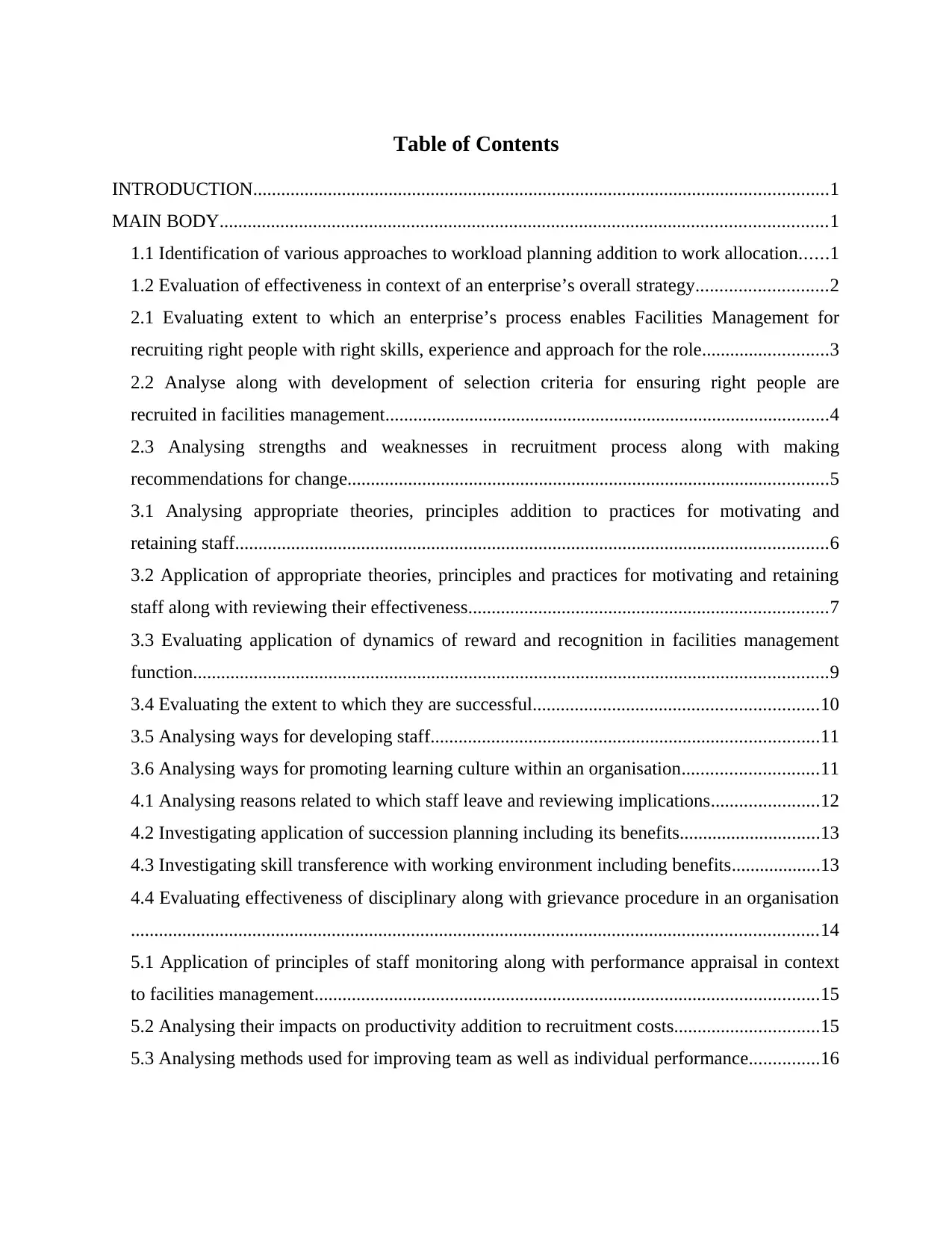
Table of Contents
INTRODUCTION...........................................................................................................................1
MAIN BODY..................................................................................................................................1
1.1 Identification of various approaches to workload planning addition to work allocation......1
1.2 Evaluation of effectiveness in context of an enterprise’s overall strategy............................2
2.1 Evaluating extent to which an enterprise’s process enables Facilities Management for
recruiting right people with right skills, experience and approach for the role...........................3
2.2 Analyse along with development of selection criteria for ensuring right people are
recruited in facilities management...............................................................................................4
2.3 Analysing strengths and weaknesses in recruitment process along with making
recommendations for change.......................................................................................................5
3.1 Analysing appropriate theories, principles addition to practices for motivating and
retaining staff...............................................................................................................................6
3.2 Application of appropriate theories, principles and practices for motivating and retaining
staff along with reviewing their effectiveness.............................................................................7
3.3 Evaluating application of dynamics of reward and recognition in facilities management
function........................................................................................................................................9
3.4 Evaluating the extent to which they are successful.............................................................10
3.5 Analysing ways for developing staff...................................................................................11
3.6 Analysing ways for promoting learning culture within an organisation.............................11
4.1 Analysing reasons related to which staff leave and reviewing implications.......................12
4.2 Investigating application of succession planning including its benefits..............................13
4.3 Investigating skill transference with working environment including benefits...................13
4.4 Evaluating effectiveness of disciplinary along with grievance procedure in an organisation
...................................................................................................................................................14
5.1 Application of principles of staff monitoring along with performance appraisal in context
to facilities management............................................................................................................15
5.2 Analysing their impacts on productivity addition to recruitment costs...............................15
5.3 Analysing methods used for improving team as well as individual performance...............16
INTRODUCTION...........................................................................................................................1
MAIN BODY..................................................................................................................................1
1.1 Identification of various approaches to workload planning addition to work allocation......1
1.2 Evaluation of effectiveness in context of an enterprise’s overall strategy............................2
2.1 Evaluating extent to which an enterprise’s process enables Facilities Management for
recruiting right people with right skills, experience and approach for the role...........................3
2.2 Analyse along with development of selection criteria for ensuring right people are
recruited in facilities management...............................................................................................4
2.3 Analysing strengths and weaknesses in recruitment process along with making
recommendations for change.......................................................................................................5
3.1 Analysing appropriate theories, principles addition to practices for motivating and
retaining staff...............................................................................................................................6
3.2 Application of appropriate theories, principles and practices for motivating and retaining
staff along with reviewing their effectiveness.............................................................................7
3.3 Evaluating application of dynamics of reward and recognition in facilities management
function........................................................................................................................................9
3.4 Evaluating the extent to which they are successful.............................................................10
3.5 Analysing ways for developing staff...................................................................................11
3.6 Analysing ways for promoting learning culture within an organisation.............................11
4.1 Analysing reasons related to which staff leave and reviewing implications.......................12
4.2 Investigating application of succession planning including its benefits..............................13
4.3 Investigating skill transference with working environment including benefits...................13
4.4 Evaluating effectiveness of disciplinary along with grievance procedure in an organisation
...................................................................................................................................................14
5.1 Application of principles of staff monitoring along with performance appraisal in context
to facilities management............................................................................................................15
5.2 Analysing their impacts on productivity addition to recruitment costs...............................15
5.3 Analysing methods used for improving team as well as individual performance...............16
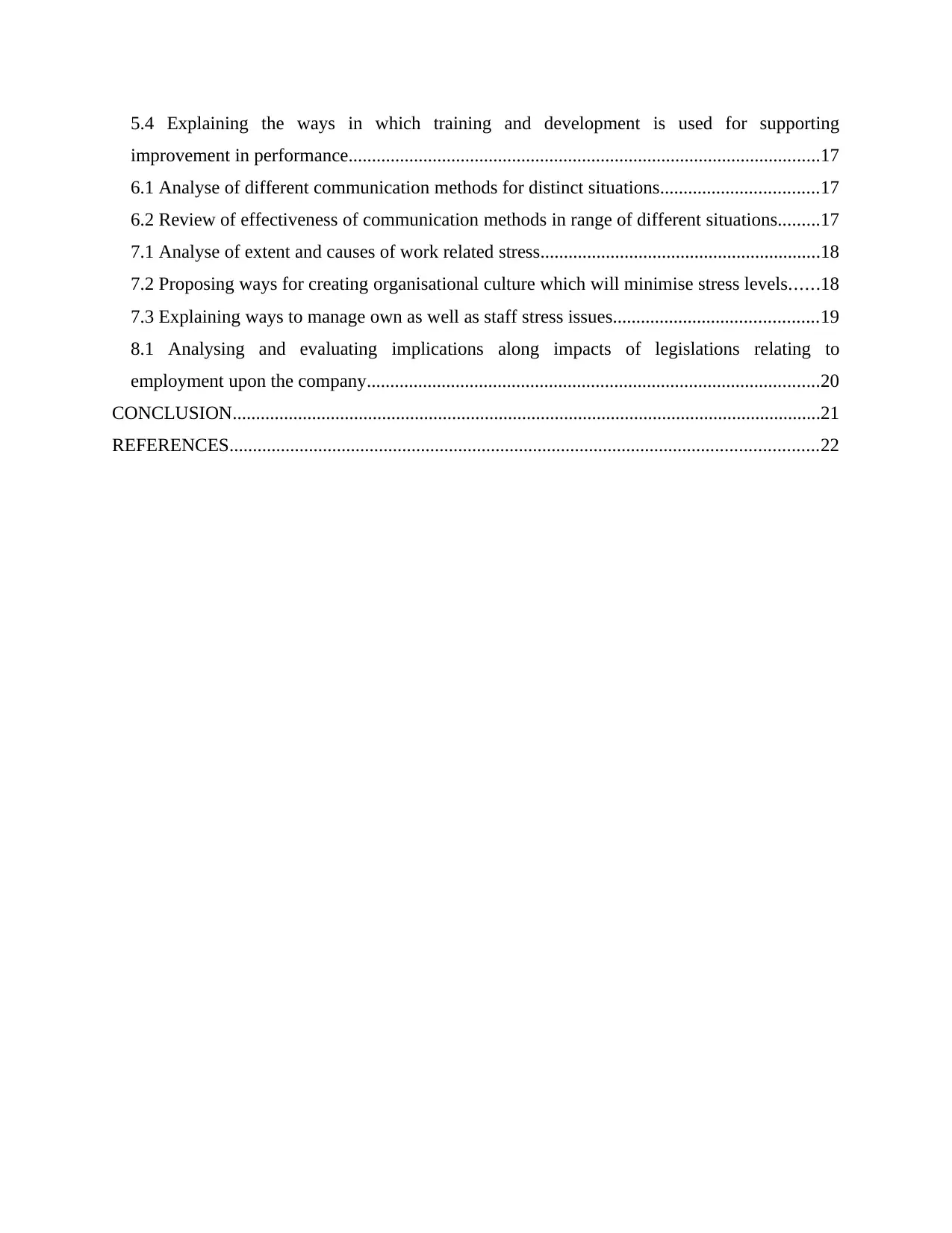
5.4 Explaining the ways in which training and development is used for supporting
improvement in performance.....................................................................................................17
6.1 Analyse of different communication methods for distinct situations..................................17
6.2 Review of effectiveness of communication methods in range of different situations.........17
7.1 Analyse of extent and causes of work related stress............................................................18
7.2 Proposing ways for creating organisational culture which will minimise stress levels......18
7.3 Explaining ways to manage own as well as staff stress issues............................................19
8.1 Analysing and evaluating implications along impacts of legislations relating to
employment upon the company.................................................................................................20
CONCLUSION..............................................................................................................................21
REFERENCES..............................................................................................................................22
improvement in performance.....................................................................................................17
6.1 Analyse of different communication methods for distinct situations..................................17
6.2 Review of effectiveness of communication methods in range of different situations.........17
7.1 Analyse of extent and causes of work related stress............................................................18
7.2 Proposing ways for creating organisational culture which will minimise stress levels......18
7.3 Explaining ways to manage own as well as staff stress issues............................................19
8.1 Analysing and evaluating implications along impacts of legislations relating to
employment upon the company.................................................................................................20
CONCLUSION..............................................................................................................................21
REFERENCES..............................................................................................................................22
⊘ This is a preview!⊘
Do you want full access?
Subscribe today to unlock all pages.

Trusted by 1+ million students worldwide
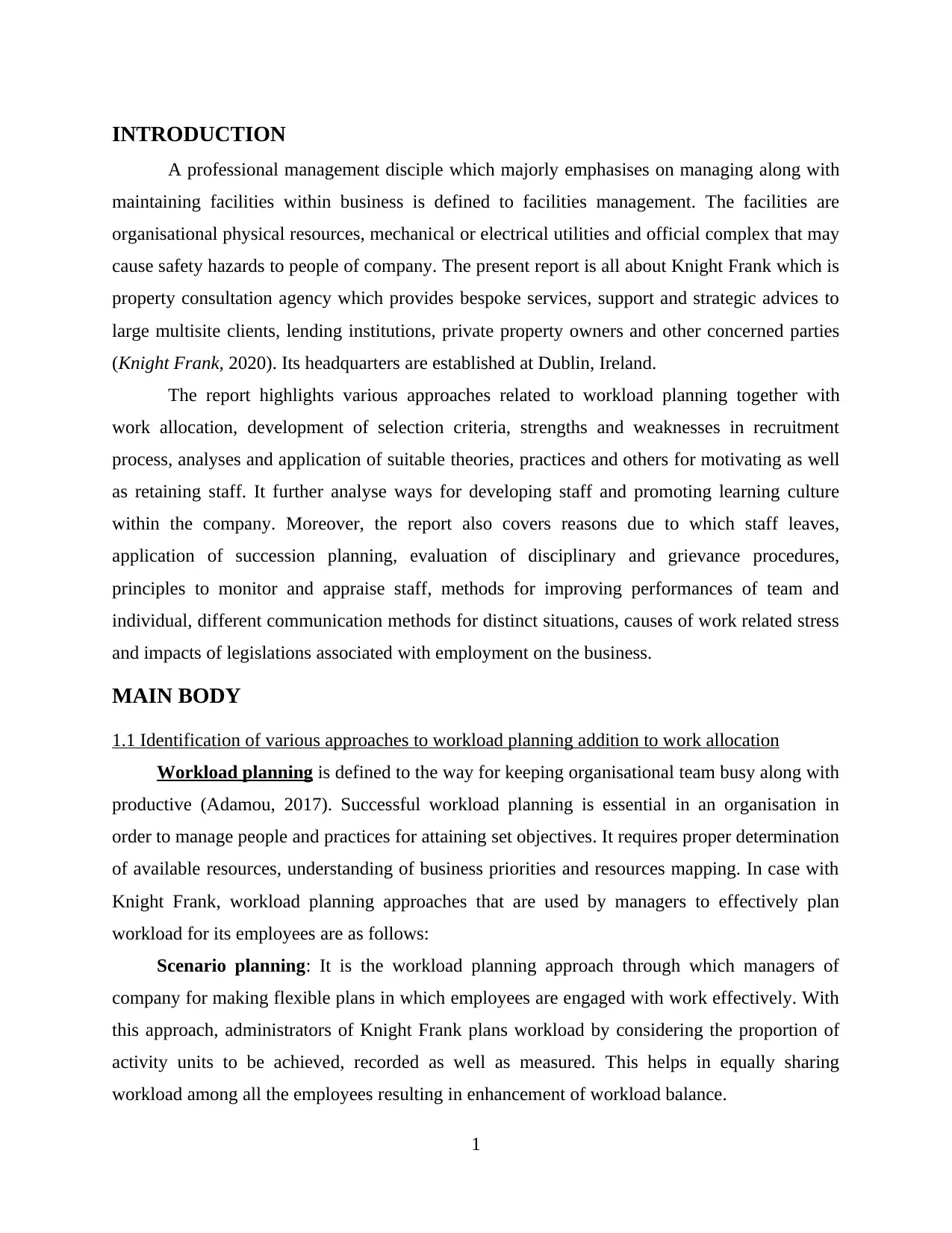
INTRODUCTION
A professional management disciple which majorly emphasises on managing along with
maintaining facilities within business is defined to facilities management. The facilities are
organisational physical resources, mechanical or electrical utilities and official complex that may
cause safety hazards to people of company. The present report is all about Knight Frank which is
property consultation agency which provides bespoke services, support and strategic advices to
large multisite clients, lending institutions, private property owners and other concerned parties
(Knight Frank, 2020). Its headquarters are established at Dublin, Ireland.
The report highlights various approaches related to workload planning together with
work allocation, development of selection criteria, strengths and weaknesses in recruitment
process, analyses and application of suitable theories, practices and others for motivating as well
as retaining staff. It further analyse ways for developing staff and promoting learning culture
within the company. Moreover, the report also covers reasons due to which staff leaves,
application of succession planning, evaluation of disciplinary and grievance procedures,
principles to monitor and appraise staff, methods for improving performances of team and
individual, different communication methods for distinct situations, causes of work related stress
and impacts of legislations associated with employment on the business.
MAIN BODY
1.1 Identification of various approaches to workload planning addition to work allocation
Workload planning is defined to the way for keeping organisational team busy along with
productive (Adamou, 2017). Successful workload planning is essential in an organisation in
order to manage people and practices for attaining set objectives. It requires proper determination
of available resources, understanding of business priorities and resources mapping. In case with
Knight Frank, workload planning approaches that are used by managers to effectively plan
workload for its employees are as follows:
Scenario planning: It is the workload planning approach through which managers of
company for making flexible plans in which employees are engaged with work effectively. With
this approach, administrators of Knight Frank plans workload by considering the proportion of
activity units to be achieved, recorded as well as measured. This helps in equally sharing
workload among all the employees resulting in enhancement of workload balance.
1
A professional management disciple which majorly emphasises on managing along with
maintaining facilities within business is defined to facilities management. The facilities are
organisational physical resources, mechanical or electrical utilities and official complex that may
cause safety hazards to people of company. The present report is all about Knight Frank which is
property consultation agency which provides bespoke services, support and strategic advices to
large multisite clients, lending institutions, private property owners and other concerned parties
(Knight Frank, 2020). Its headquarters are established at Dublin, Ireland.
The report highlights various approaches related to workload planning together with
work allocation, development of selection criteria, strengths and weaknesses in recruitment
process, analyses and application of suitable theories, practices and others for motivating as well
as retaining staff. It further analyse ways for developing staff and promoting learning culture
within the company. Moreover, the report also covers reasons due to which staff leaves,
application of succession planning, evaluation of disciplinary and grievance procedures,
principles to monitor and appraise staff, methods for improving performances of team and
individual, different communication methods for distinct situations, causes of work related stress
and impacts of legislations associated with employment on the business.
MAIN BODY
1.1 Identification of various approaches to workload planning addition to work allocation
Workload planning is defined to the way for keeping organisational team busy along with
productive (Adamou, 2017). Successful workload planning is essential in an organisation in
order to manage people and practices for attaining set objectives. It requires proper determination
of available resources, understanding of business priorities and resources mapping. In case with
Knight Frank, workload planning approaches that are used by managers to effectively plan
workload for its employees are as follows:
Scenario planning: It is the workload planning approach through which managers of
company for making flexible plans in which employees are engaged with work effectively. With
this approach, administrators of Knight Frank plans workload by considering the proportion of
activity units to be achieved, recorded as well as measured. This helps in equally sharing
workload among all the employees resulting in enhancement of workload balance.
1
Paraphrase This Document
Need a fresh take? Get an instant paraphrase of this document with our AI Paraphraser
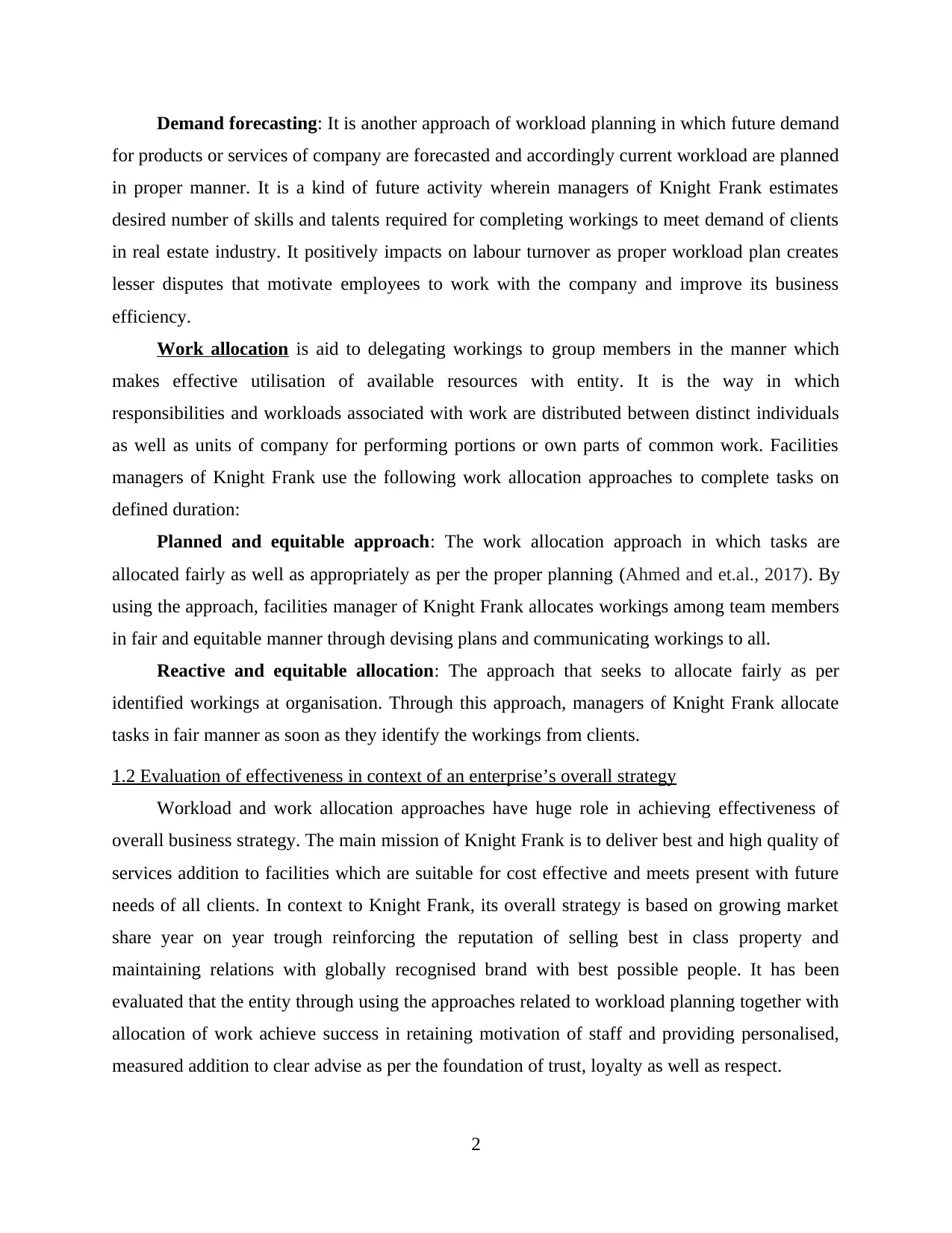
Demand forecasting: It is another approach of workload planning in which future demand
for products or services of company are forecasted and accordingly current workload are planned
in proper manner. It is a kind of future activity wherein managers of Knight Frank estimates
desired number of skills and talents required for completing workings to meet demand of clients
in real estate industry. It positively impacts on labour turnover as proper workload plan creates
lesser disputes that motivate employees to work with the company and improve its business
efficiency.
Work allocation is aid to delegating workings to group members in the manner which
makes effective utilisation of available resources with entity. It is the way in which
responsibilities and workloads associated with work are distributed between distinct individuals
as well as units of company for performing portions or own parts of common work. Facilities
managers of Knight Frank use the following work allocation approaches to complete tasks on
defined duration:
Planned and equitable approach: The work allocation approach in which tasks are
allocated fairly as well as appropriately as per the proper planning (Ahmed and et.al., 2017). By
using the approach, facilities manager of Knight Frank allocates workings among team members
in fair and equitable manner through devising plans and communicating workings to all.
Reactive and equitable allocation: The approach that seeks to allocate fairly as per
identified workings at organisation. Through this approach, managers of Knight Frank allocate
tasks in fair manner as soon as they identify the workings from clients.
1.2 Evaluation of effectiveness in context of an enterprise’s overall strategy
Workload and work allocation approaches have huge role in achieving effectiveness of
overall business strategy. The main mission of Knight Frank is to deliver best and high quality of
services addition to facilities which are suitable for cost effective and meets present with future
needs of all clients. In context to Knight Frank, its overall strategy is based on growing market
share year on year trough reinforcing the reputation of selling best in class property and
maintaining relations with globally recognised brand with best possible people. It has been
evaluated that the entity through using the approaches related to workload planning together with
allocation of work achieve success in retaining motivation of staff and providing personalised,
measured addition to clear advise as per the foundation of trust, loyalty as well as respect.
2
for products or services of company are forecasted and accordingly current workload are planned
in proper manner. It is a kind of future activity wherein managers of Knight Frank estimates
desired number of skills and talents required for completing workings to meet demand of clients
in real estate industry. It positively impacts on labour turnover as proper workload plan creates
lesser disputes that motivate employees to work with the company and improve its business
efficiency.
Work allocation is aid to delegating workings to group members in the manner which
makes effective utilisation of available resources with entity. It is the way in which
responsibilities and workloads associated with work are distributed between distinct individuals
as well as units of company for performing portions or own parts of common work. Facilities
managers of Knight Frank use the following work allocation approaches to complete tasks on
defined duration:
Planned and equitable approach: The work allocation approach in which tasks are
allocated fairly as well as appropriately as per the proper planning (Ahmed and et.al., 2017). By
using the approach, facilities manager of Knight Frank allocates workings among team members
in fair and equitable manner through devising plans and communicating workings to all.
Reactive and equitable allocation: The approach that seeks to allocate fairly as per
identified workings at organisation. Through this approach, managers of Knight Frank allocate
tasks in fair manner as soon as they identify the workings from clients.
1.2 Evaluation of effectiveness in context of an enterprise’s overall strategy
Workload and work allocation approaches have huge role in achieving effectiveness of
overall business strategy. The main mission of Knight Frank is to deliver best and high quality of
services addition to facilities which are suitable for cost effective and meets present with future
needs of all clients. In context to Knight Frank, its overall strategy is based on growing market
share year on year trough reinforcing the reputation of selling best in class property and
maintaining relations with globally recognised brand with best possible people. It has been
evaluated that the entity through using the approaches related to workload planning together with
allocation of work achieve success in retaining motivation of staff and providing personalised,
measured addition to clear advise as per the foundation of trust, loyalty as well as respect.
2
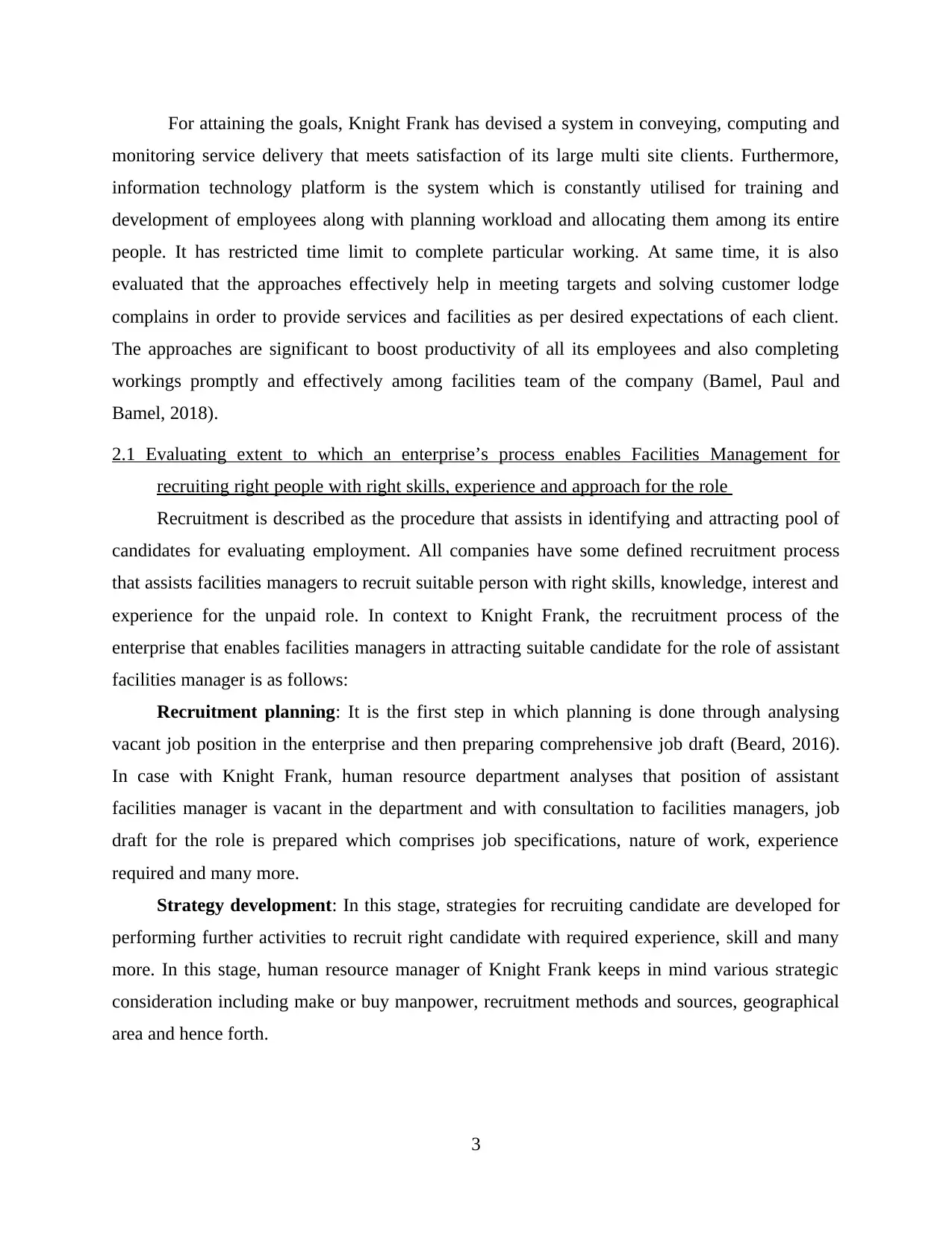
For attaining the goals, Knight Frank has devised a system in conveying, computing and
monitoring service delivery that meets satisfaction of its large multi site clients. Furthermore,
information technology platform is the system which is constantly utilised for training and
development of employees along with planning workload and allocating them among its entire
people. It has restricted time limit to complete particular working. At same time, it is also
evaluated that the approaches effectively help in meeting targets and solving customer lodge
complains in order to provide services and facilities as per desired expectations of each client.
The approaches are significant to boost productivity of all its employees and also completing
workings promptly and effectively among facilities team of the company (Bamel, Paul and
Bamel, 2018).
2.1 Evaluating extent to which an enterprise’s process enables Facilities Management for
recruiting right people with right skills, experience and approach for the role
Recruitment is described as the procedure that assists in identifying and attracting pool of
candidates for evaluating employment. All companies have some defined recruitment process
that assists facilities managers to recruit suitable person with right skills, knowledge, interest and
experience for the unpaid role. In context to Knight Frank, the recruitment process of the
enterprise that enables facilities managers in attracting suitable candidate for the role of assistant
facilities manager is as follows:
Recruitment planning: It is the first step in which planning is done through analysing
vacant job position in the enterprise and then preparing comprehensive job draft (Beard, 2016).
In case with Knight Frank, human resource department analyses that position of assistant
facilities manager is vacant in the department and with consultation to facilities managers, job
draft for the role is prepared which comprises job specifications, nature of work, experience
required and many more.
Strategy development: In this stage, strategies for recruiting candidate are developed for
performing further activities to recruit right candidate with required experience, skill and many
more. In this stage, human resource manager of Knight Frank keeps in mind various strategic
consideration including make or buy manpower, recruitment methods and sources, geographical
area and hence forth.
3
monitoring service delivery that meets satisfaction of its large multi site clients. Furthermore,
information technology platform is the system which is constantly utilised for training and
development of employees along with planning workload and allocating them among its entire
people. It has restricted time limit to complete particular working. At same time, it is also
evaluated that the approaches effectively help in meeting targets and solving customer lodge
complains in order to provide services and facilities as per desired expectations of each client.
The approaches are significant to boost productivity of all its employees and also completing
workings promptly and effectively among facilities team of the company (Bamel, Paul and
Bamel, 2018).
2.1 Evaluating extent to which an enterprise’s process enables Facilities Management for
recruiting right people with right skills, experience and approach for the role
Recruitment is described as the procedure that assists in identifying and attracting pool of
candidates for evaluating employment. All companies have some defined recruitment process
that assists facilities managers to recruit suitable person with right skills, knowledge, interest and
experience for the unpaid role. In context to Knight Frank, the recruitment process of the
enterprise that enables facilities managers in attracting suitable candidate for the role of assistant
facilities manager is as follows:
Recruitment planning: It is the first step in which planning is done through analysing
vacant job position in the enterprise and then preparing comprehensive job draft (Beard, 2016).
In case with Knight Frank, human resource department analyses that position of assistant
facilities manager is vacant in the department and with consultation to facilities managers, job
draft for the role is prepared which comprises job specifications, nature of work, experience
required and many more.
Strategy development: In this stage, strategies for recruiting candidate are developed for
performing further activities to recruit right candidate with required experience, skill and many
more. In this stage, human resource manager of Knight Frank keeps in mind various strategic
consideration including make or buy manpower, recruitment methods and sources, geographical
area and hence forth.
3
⊘ This is a preview!⊘
Do you want full access?
Subscribe today to unlock all pages.

Trusted by 1+ million students worldwide
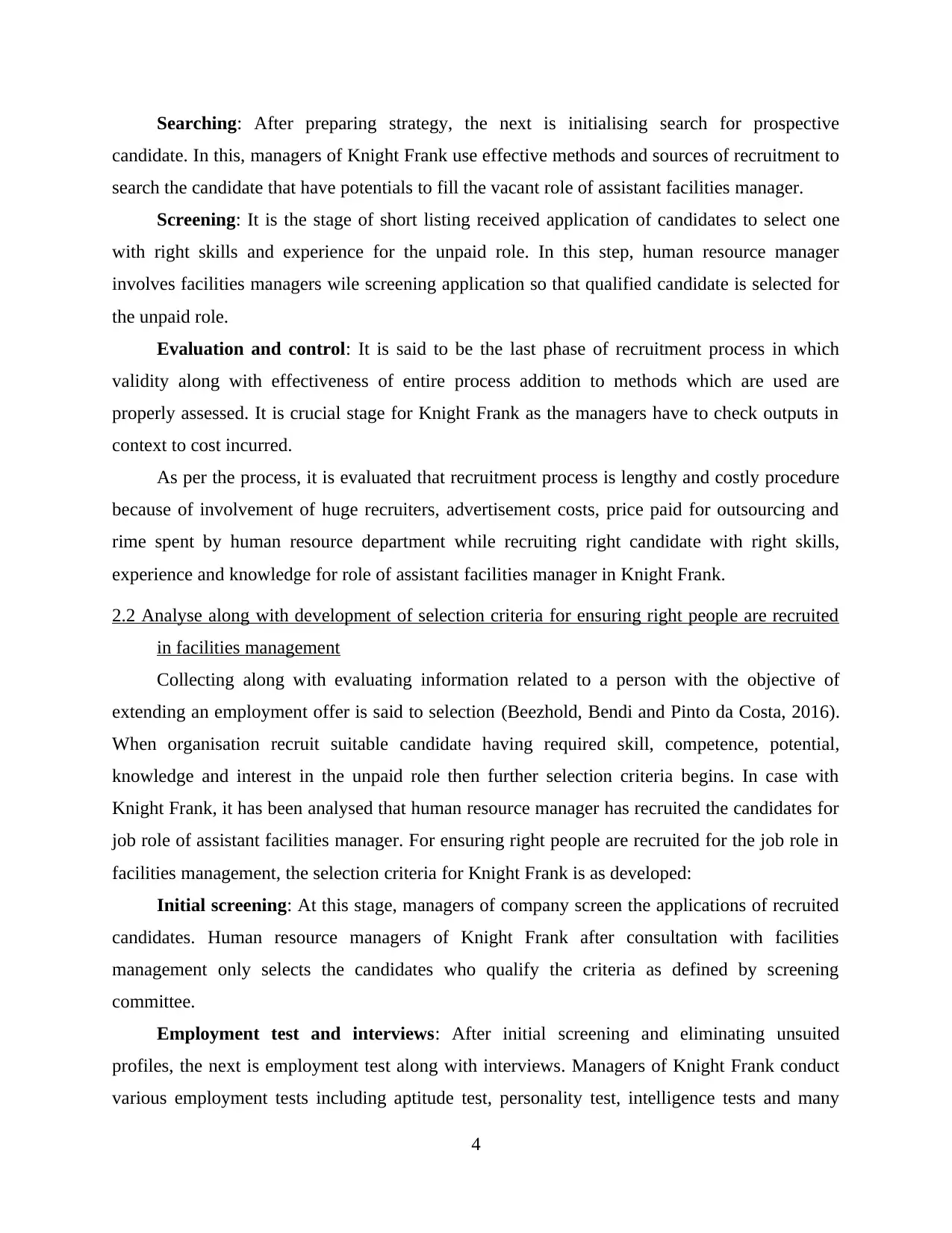
Searching: After preparing strategy, the next is initialising search for prospective
candidate. In this, managers of Knight Frank use effective methods and sources of recruitment to
search the candidate that have potentials to fill the vacant role of assistant facilities manager.
Screening: It is the stage of short listing received application of candidates to select one
with right skills and experience for the unpaid role. In this step, human resource manager
involves facilities managers wile screening application so that qualified candidate is selected for
the unpaid role.
Evaluation and control: It is said to be the last phase of recruitment process in which
validity along with effectiveness of entire process addition to methods which are used are
properly assessed. It is crucial stage for Knight Frank as the managers have to check outputs in
context to cost incurred.
As per the process, it is evaluated that recruitment process is lengthy and costly procedure
because of involvement of huge recruiters, advertisement costs, price paid for outsourcing and
rime spent by human resource department while recruiting right candidate with right skills,
experience and knowledge for role of assistant facilities manager in Knight Frank.
2.2 Analyse along with development of selection criteria for ensuring right people are recruited
in facilities management
Collecting along with evaluating information related to a person with the objective of
extending an employment offer is said to selection (Beezhold, Bendi and Pinto da Costa, 2016).
When organisation recruit suitable candidate having required skill, competence, potential,
knowledge and interest in the unpaid role then further selection criteria begins. In case with
Knight Frank, it has been analysed that human resource manager has recruited the candidates for
job role of assistant facilities manager. For ensuring right people are recruited for the job role in
facilities management, the selection criteria for Knight Frank is as developed:
Initial screening: At this stage, managers of company screen the applications of recruited
candidates. Human resource managers of Knight Frank after consultation with facilities
management only selects the candidates who qualify the criteria as defined by screening
committee.
Employment test and interviews: After initial screening and eliminating unsuited
profiles, the next is employment test along with interviews. Managers of Knight Frank conduct
various employment tests including aptitude test, personality test, intelligence tests and many
4
candidate. In this, managers of Knight Frank use effective methods and sources of recruitment to
search the candidate that have potentials to fill the vacant role of assistant facilities manager.
Screening: It is the stage of short listing received application of candidates to select one
with right skills and experience for the unpaid role. In this step, human resource manager
involves facilities managers wile screening application so that qualified candidate is selected for
the unpaid role.
Evaluation and control: It is said to be the last phase of recruitment process in which
validity along with effectiveness of entire process addition to methods which are used are
properly assessed. It is crucial stage for Knight Frank as the managers have to check outputs in
context to cost incurred.
As per the process, it is evaluated that recruitment process is lengthy and costly procedure
because of involvement of huge recruiters, advertisement costs, price paid for outsourcing and
rime spent by human resource department while recruiting right candidate with right skills,
experience and knowledge for role of assistant facilities manager in Knight Frank.
2.2 Analyse along with development of selection criteria for ensuring right people are recruited
in facilities management
Collecting along with evaluating information related to a person with the objective of
extending an employment offer is said to selection (Beezhold, Bendi and Pinto da Costa, 2016).
When organisation recruit suitable candidate having required skill, competence, potential,
knowledge and interest in the unpaid role then further selection criteria begins. In case with
Knight Frank, it has been analysed that human resource manager has recruited the candidates for
job role of assistant facilities manager. For ensuring right people are recruited for the job role in
facilities management, the selection criteria for Knight Frank is as developed:
Initial screening: At this stage, managers of company screen the applications of recruited
candidates. Human resource managers of Knight Frank after consultation with facilities
management only selects the candidates who qualify the criteria as defined by screening
committee.
Employment test and interviews: After initial screening and eliminating unsuited
profiles, the next is employment test along with interviews. Managers of Knight Frank conduct
various employment tests including aptitude test, personality test, intelligence tests and many
4
Paraphrase This Document
Need a fresh take? Get an instant paraphrase of this document with our AI Paraphraser
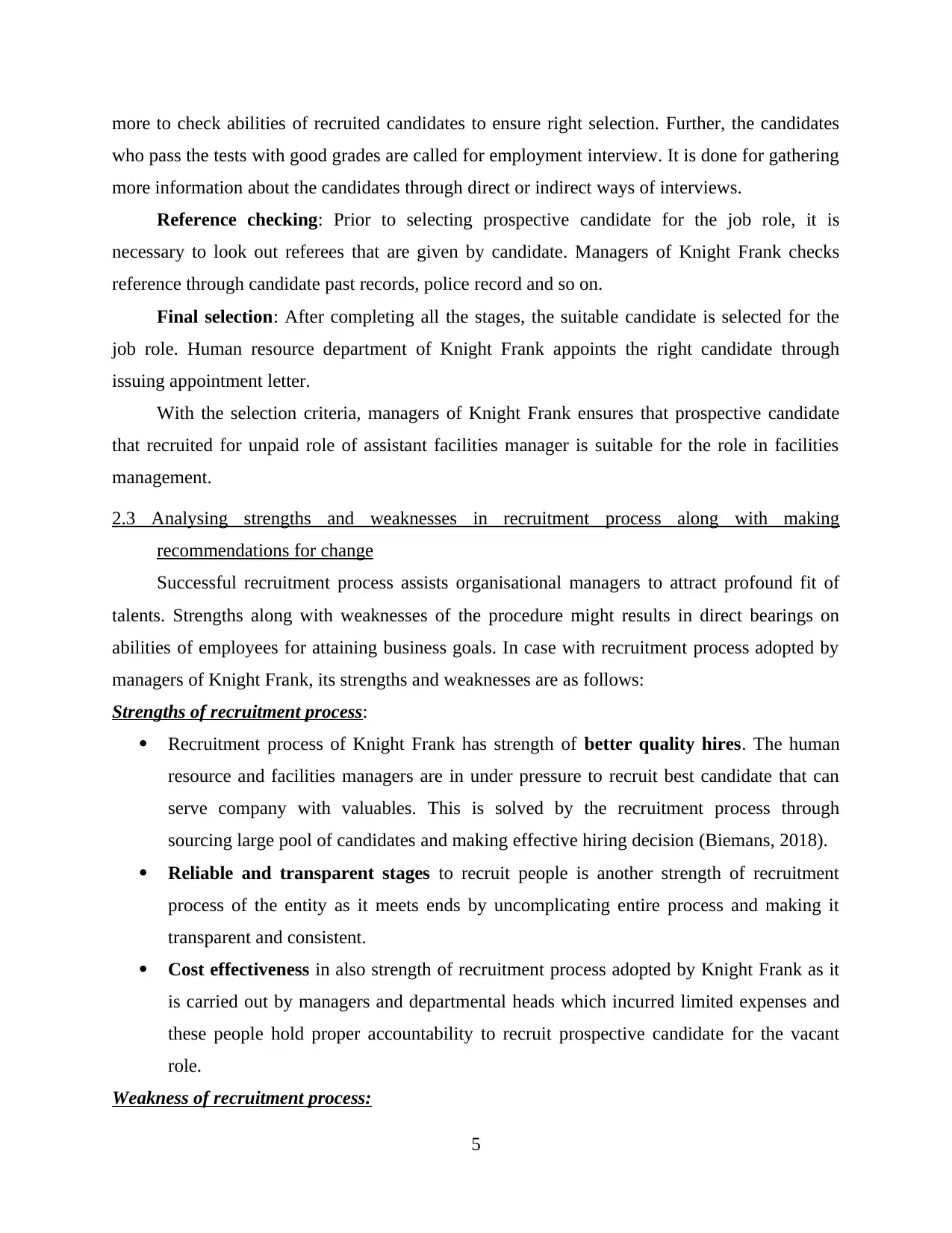
more to check abilities of recruited candidates to ensure right selection. Further, the candidates
who pass the tests with good grades are called for employment interview. It is done for gathering
more information about the candidates through direct or indirect ways of interviews.
Reference checking: Prior to selecting prospective candidate for the job role, it is
necessary to look out referees that are given by candidate. Managers of Knight Frank checks
reference through candidate past records, police record and so on.
Final selection: After completing all the stages, the suitable candidate is selected for the
job role. Human resource department of Knight Frank appoints the right candidate through
issuing appointment letter.
With the selection criteria, managers of Knight Frank ensures that prospective candidate
that recruited for unpaid role of assistant facilities manager is suitable for the role in facilities
management.
2.3 Analysing strengths and weaknesses in recruitment process along with making
recommendations for change
Successful recruitment process assists organisational managers to attract profound fit of
talents. Strengths along with weaknesses of the procedure might results in direct bearings on
abilities of employees for attaining business goals. In case with recruitment process adopted by
managers of Knight Frank, its strengths and weaknesses are as follows:
Strengths of recruitment process:
Recruitment process of Knight Frank has strength of better quality hires. The human
resource and facilities managers are in under pressure to recruit best candidate that can
serve company with valuables. This is solved by the recruitment process through
sourcing large pool of candidates and making effective hiring decision (Biemans, 2018).
Reliable and transparent stages to recruit people is another strength of recruitment
process of the entity as it meets ends by uncomplicating entire process and making it
transparent and consistent.
Cost effectiveness in also strength of recruitment process adopted by Knight Frank as it
is carried out by managers and departmental heads which incurred limited expenses and
these people hold proper accountability to recruit prospective candidate for the vacant
role.
Weakness of recruitment process:
5
who pass the tests with good grades are called for employment interview. It is done for gathering
more information about the candidates through direct or indirect ways of interviews.
Reference checking: Prior to selecting prospective candidate for the job role, it is
necessary to look out referees that are given by candidate. Managers of Knight Frank checks
reference through candidate past records, police record and so on.
Final selection: After completing all the stages, the suitable candidate is selected for the
job role. Human resource department of Knight Frank appoints the right candidate through
issuing appointment letter.
With the selection criteria, managers of Knight Frank ensures that prospective candidate
that recruited for unpaid role of assistant facilities manager is suitable for the role in facilities
management.
2.3 Analysing strengths and weaknesses in recruitment process along with making
recommendations for change
Successful recruitment process assists organisational managers to attract profound fit of
talents. Strengths along with weaknesses of the procedure might results in direct bearings on
abilities of employees for attaining business goals. In case with recruitment process adopted by
managers of Knight Frank, its strengths and weaknesses are as follows:
Strengths of recruitment process:
Recruitment process of Knight Frank has strength of better quality hires. The human
resource and facilities managers are in under pressure to recruit best candidate that can
serve company with valuables. This is solved by the recruitment process through
sourcing large pool of candidates and making effective hiring decision (Biemans, 2018).
Reliable and transparent stages to recruit people is another strength of recruitment
process of the entity as it meets ends by uncomplicating entire process and making it
transparent and consistent.
Cost effectiveness in also strength of recruitment process adopted by Knight Frank as it
is carried out by managers and departmental heads which incurred limited expenses and
these people hold proper accountability to recruit prospective candidate for the vacant
role.
Weakness of recruitment process:
5
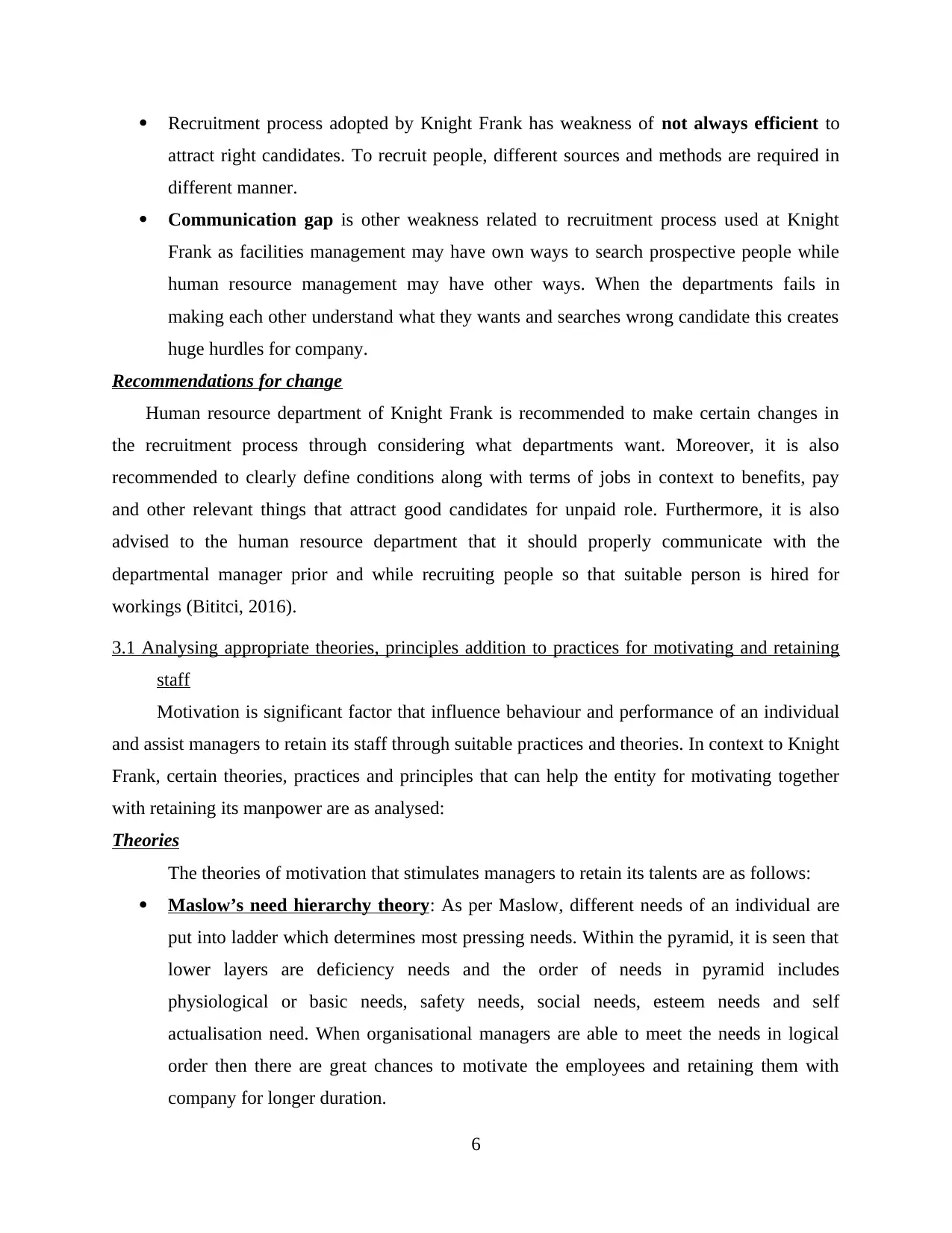
Recruitment process adopted by Knight Frank has weakness of not always efficient to
attract right candidates. To recruit people, different sources and methods are required in
different manner.
Communication gap is other weakness related to recruitment process used at Knight
Frank as facilities management may have own ways to search prospective people while
human resource management may have other ways. When the departments fails in
making each other understand what they wants and searches wrong candidate this creates
huge hurdles for company.
Recommendations for change
Human resource department of Knight Frank is recommended to make certain changes in
the recruitment process through considering what departments want. Moreover, it is also
recommended to clearly define conditions along with terms of jobs in context to benefits, pay
and other relevant things that attract good candidates for unpaid role. Furthermore, it is also
advised to the human resource department that it should properly communicate with the
departmental manager prior and while recruiting people so that suitable person is hired for
workings (Bititci, 2016).
3.1 Analysing appropriate theories, principles addition to practices for motivating and retaining
staff
Motivation is significant factor that influence behaviour and performance of an individual
and assist managers to retain its staff through suitable practices and theories. In context to Knight
Frank, certain theories, practices and principles that can help the entity for motivating together
with retaining its manpower are as analysed:
Theories
The theories of motivation that stimulates managers to retain its talents are as follows:
Maslow’s need hierarchy theory: As per Maslow, different needs of an individual are
put into ladder which determines most pressing needs. Within the pyramid, it is seen that
lower layers are deficiency needs and the order of needs in pyramid includes
physiological or basic needs, safety needs, social needs, esteem needs and self
actualisation need. When organisational managers are able to meet the needs in logical
order then there are great chances to motivate the employees and retaining them with
company for longer duration.
6
attract right candidates. To recruit people, different sources and methods are required in
different manner.
Communication gap is other weakness related to recruitment process used at Knight
Frank as facilities management may have own ways to search prospective people while
human resource management may have other ways. When the departments fails in
making each other understand what they wants and searches wrong candidate this creates
huge hurdles for company.
Recommendations for change
Human resource department of Knight Frank is recommended to make certain changes in
the recruitment process through considering what departments want. Moreover, it is also
recommended to clearly define conditions along with terms of jobs in context to benefits, pay
and other relevant things that attract good candidates for unpaid role. Furthermore, it is also
advised to the human resource department that it should properly communicate with the
departmental manager prior and while recruiting people so that suitable person is hired for
workings (Bititci, 2016).
3.1 Analysing appropriate theories, principles addition to practices for motivating and retaining
staff
Motivation is significant factor that influence behaviour and performance of an individual
and assist managers to retain its staff through suitable practices and theories. In context to Knight
Frank, certain theories, practices and principles that can help the entity for motivating together
with retaining its manpower are as analysed:
Theories
The theories of motivation that stimulates managers to retain its talents are as follows:
Maslow’s need hierarchy theory: As per Maslow, different needs of an individual are
put into ladder which determines most pressing needs. Within the pyramid, it is seen that
lower layers are deficiency needs and the order of needs in pyramid includes
physiological or basic needs, safety needs, social needs, esteem needs and self
actualisation need. When organisational managers are able to meet the needs in logical
order then there are great chances to motivate the employees and retaining them with
company for longer duration.
6
⊘ This is a preview!⊘
Do you want full access?
Subscribe today to unlock all pages.

Trusted by 1+ million students worldwide
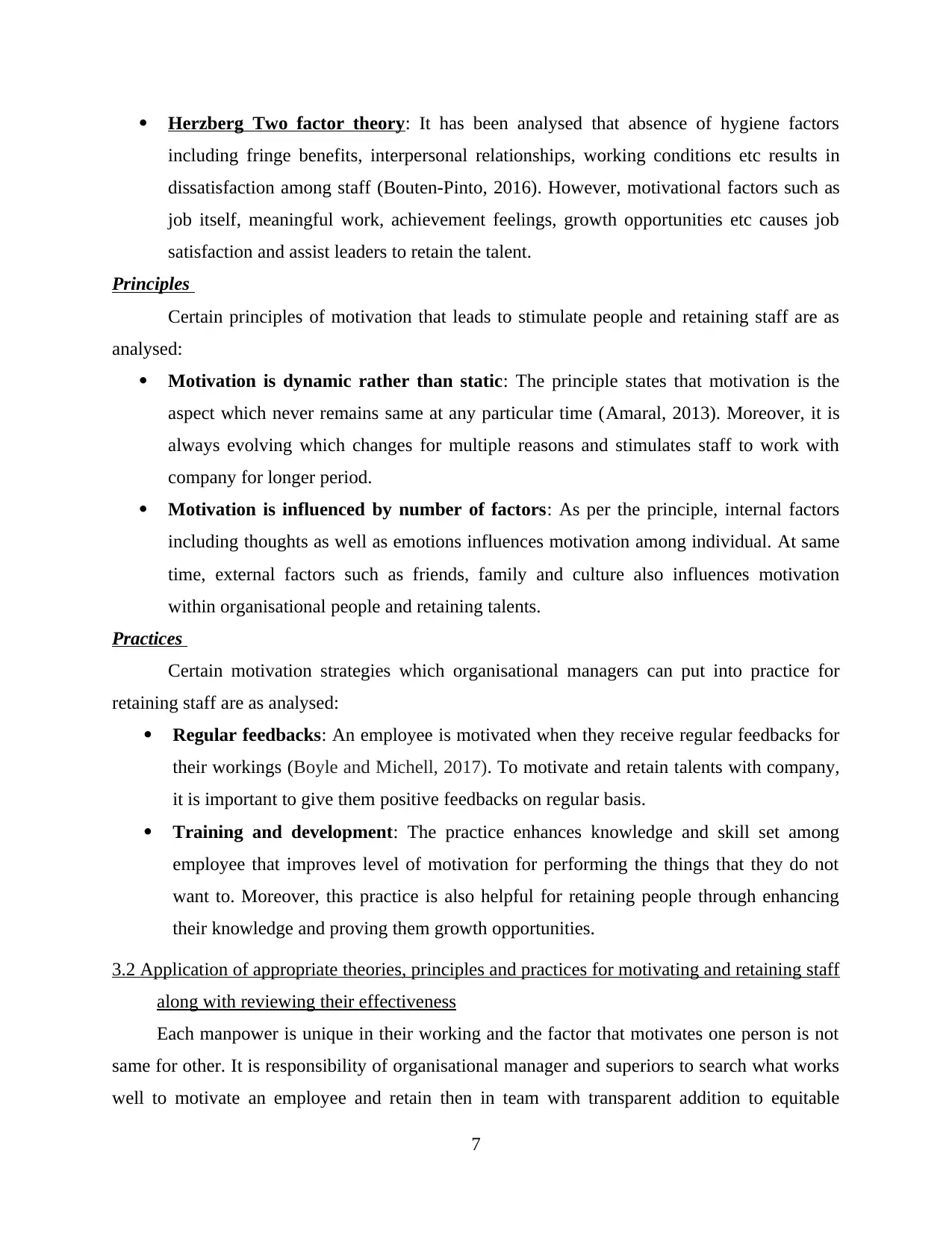
Herzberg Two factor theory: It has been analysed that absence of hygiene factors
including fringe benefits, interpersonal relationships, working conditions etc results in
dissatisfaction among staff (Bouten-Pinto, 2016). However, motivational factors such as
job itself, meaningful work, achievement feelings, growth opportunities etc causes job
satisfaction and assist leaders to retain the talent.
Principles
Certain principles of motivation that leads to stimulate people and retaining staff are as
analysed:
Motivation is dynamic rather than static: The principle states that motivation is the
aspect which never remains same at any particular time (Amaral, 2013). Moreover, it is
always evolving which changes for multiple reasons and stimulates staff to work with
company for longer period.
Motivation is influenced by number of factors: As per the principle, internal factors
including thoughts as well as emotions influences motivation among individual. At same
time, external factors such as friends, family and culture also influences motivation
within organisational people and retaining talents.
Practices
Certain motivation strategies which organisational managers can put into practice for
retaining staff are as analysed:
Regular feedbacks: An employee is motivated when they receive regular feedbacks for
their workings (Boyle and Michell, 2017). To motivate and retain talents with company,
it is important to give them positive feedbacks on regular basis.
Training and development: The practice enhances knowledge and skill set among
employee that improves level of motivation for performing the things that they do not
want to. Moreover, this practice is also helpful for retaining people through enhancing
their knowledge and proving them growth opportunities.
3.2 Application of appropriate theories, principles and practices for motivating and retaining staff
along with reviewing their effectiveness
Each manpower is unique in their working and the factor that motivates one person is not
same for other. It is responsibility of organisational manager and superiors to search what works
well to motivate an employee and retain then in team with transparent addition to equitable
7
including fringe benefits, interpersonal relationships, working conditions etc results in
dissatisfaction among staff (Bouten-Pinto, 2016). However, motivational factors such as
job itself, meaningful work, achievement feelings, growth opportunities etc causes job
satisfaction and assist leaders to retain the talent.
Principles
Certain principles of motivation that leads to stimulate people and retaining staff are as
analysed:
Motivation is dynamic rather than static: The principle states that motivation is the
aspect which never remains same at any particular time (Amaral, 2013). Moreover, it is
always evolving which changes for multiple reasons and stimulates staff to work with
company for longer period.
Motivation is influenced by number of factors: As per the principle, internal factors
including thoughts as well as emotions influences motivation among individual. At same
time, external factors such as friends, family and culture also influences motivation
within organisational people and retaining talents.
Practices
Certain motivation strategies which organisational managers can put into practice for
retaining staff are as analysed:
Regular feedbacks: An employee is motivated when they receive regular feedbacks for
their workings (Boyle and Michell, 2017). To motivate and retain talents with company,
it is important to give them positive feedbacks on regular basis.
Training and development: The practice enhances knowledge and skill set among
employee that improves level of motivation for performing the things that they do not
want to. Moreover, this practice is also helpful for retaining people through enhancing
their knowledge and proving them growth opportunities.
3.2 Application of appropriate theories, principles and practices for motivating and retaining staff
along with reviewing their effectiveness
Each manpower is unique in their working and the factor that motivates one person is not
same for other. It is responsibility of organisational manager and superiors to search what works
well to motivate an employee and retain then in team with transparent addition to equitable
7
Paraphrase This Document
Need a fresh take? Get an instant paraphrase of this document with our AI Paraphraser
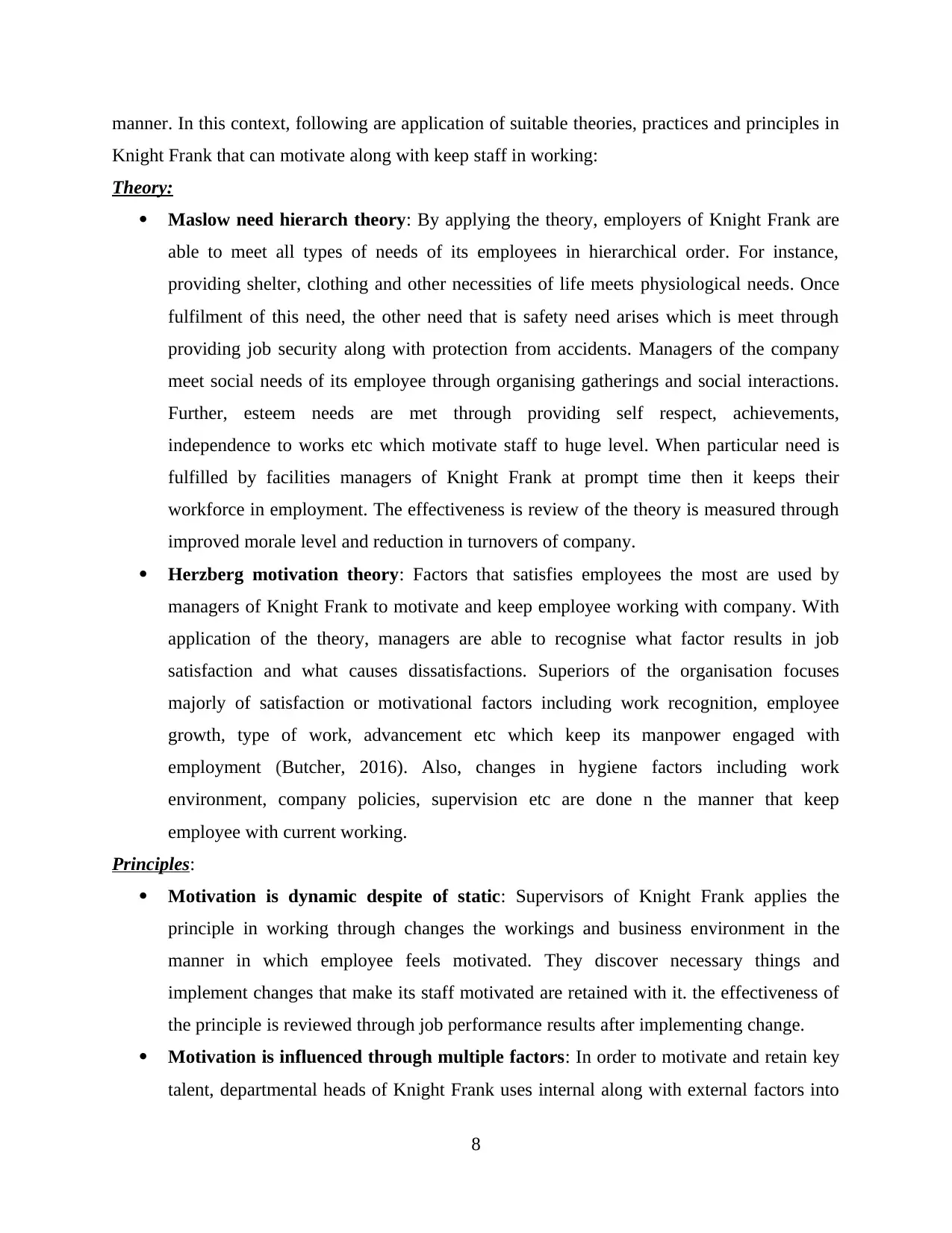
manner. In this context, following are application of suitable theories, practices and principles in
Knight Frank that can motivate along with keep staff in working:
Theory:
Maslow need hierarch theory: By applying the theory, employers of Knight Frank are
able to meet all types of needs of its employees in hierarchical order. For instance,
providing shelter, clothing and other necessities of life meets physiological needs. Once
fulfilment of this need, the other need that is safety need arises which is meet through
providing job security along with protection from accidents. Managers of the company
meet social needs of its employee through organising gatherings and social interactions.
Further, esteem needs are met through providing self respect, achievements,
independence to works etc which motivate staff to huge level. When particular need is
fulfilled by facilities managers of Knight Frank at prompt time then it keeps their
workforce in employment. The effectiveness is review of the theory is measured through
improved morale level and reduction in turnovers of company.
Herzberg motivation theory: Factors that satisfies employees the most are used by
managers of Knight Frank to motivate and keep employee working with company. With
application of the theory, managers are able to recognise what factor results in job
satisfaction and what causes dissatisfactions. Superiors of the organisation focuses
majorly of satisfaction or motivational factors including work recognition, employee
growth, type of work, advancement etc which keep its manpower engaged with
employment (Butcher, 2016). Also, changes in hygiene factors including work
environment, company policies, supervision etc are done n the manner that keep
employee with current working.
Principles:
Motivation is dynamic despite of static: Supervisors of Knight Frank applies the
principle in working through changes the workings and business environment in the
manner in which employee feels motivated. They discover necessary things and
implement changes that make its staff motivated are retained with it. the effectiveness of
the principle is reviewed through job performance results after implementing change.
Motivation is influenced through multiple factors: In order to motivate and retain key
talent, departmental heads of Knight Frank uses internal along with external factors into
8
Knight Frank that can motivate along with keep staff in working:
Theory:
Maslow need hierarch theory: By applying the theory, employers of Knight Frank are
able to meet all types of needs of its employees in hierarchical order. For instance,
providing shelter, clothing and other necessities of life meets physiological needs. Once
fulfilment of this need, the other need that is safety need arises which is meet through
providing job security along with protection from accidents. Managers of the company
meet social needs of its employee through organising gatherings and social interactions.
Further, esteem needs are met through providing self respect, achievements,
independence to works etc which motivate staff to huge level. When particular need is
fulfilled by facilities managers of Knight Frank at prompt time then it keeps their
workforce in employment. The effectiveness is review of the theory is measured through
improved morale level and reduction in turnovers of company.
Herzberg motivation theory: Factors that satisfies employees the most are used by
managers of Knight Frank to motivate and keep employee working with company. With
application of the theory, managers are able to recognise what factor results in job
satisfaction and what causes dissatisfactions. Superiors of the organisation focuses
majorly of satisfaction or motivational factors including work recognition, employee
growth, type of work, advancement etc which keep its manpower engaged with
employment (Butcher, 2016). Also, changes in hygiene factors including work
environment, company policies, supervision etc are done n the manner that keep
employee with current working.
Principles:
Motivation is dynamic despite of static: Supervisors of Knight Frank applies the
principle in working through changes the workings and business environment in the
manner in which employee feels motivated. They discover necessary things and
implement changes that make its staff motivated are retained with it. the effectiveness of
the principle is reviewed through job performance results after implementing change.
Motivation is influenced through multiple factors: In order to motivate and retain key
talent, departmental heads of Knight Frank uses internal along with external factors into
8
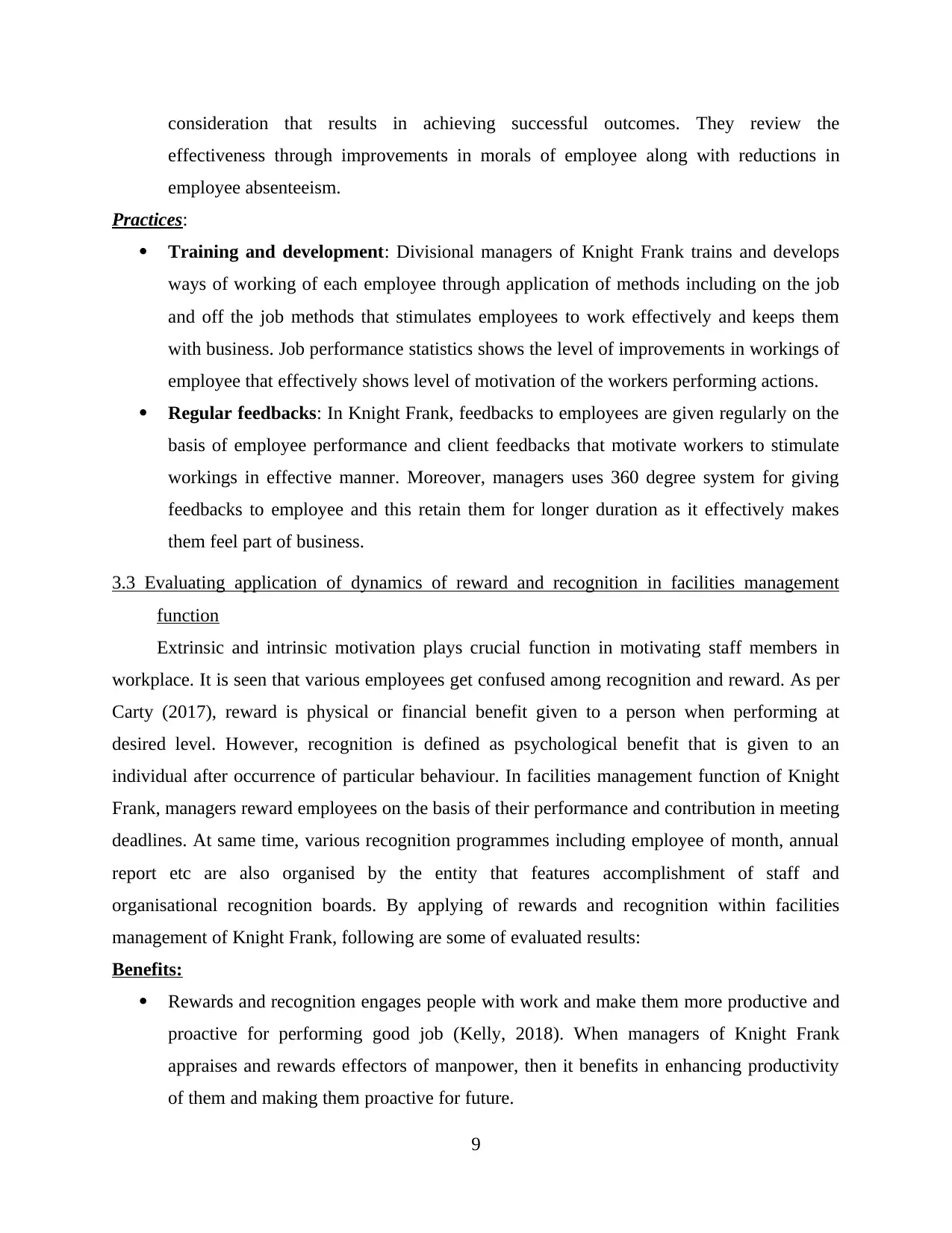
consideration that results in achieving successful outcomes. They review the
effectiveness through improvements in morals of employee along with reductions in
employee absenteeism.
Practices:
Training and development: Divisional managers of Knight Frank trains and develops
ways of working of each employee through application of methods including on the job
and off the job methods that stimulates employees to work effectively and keeps them
with business. Job performance statistics shows the level of improvements in workings of
employee that effectively shows level of motivation of the workers performing actions.
Regular feedbacks: In Knight Frank, feedbacks to employees are given regularly on the
basis of employee performance and client feedbacks that motivate workers to stimulate
workings in effective manner. Moreover, managers uses 360 degree system for giving
feedbacks to employee and this retain them for longer duration as it effectively makes
them feel part of business.
3.3 Evaluating application of dynamics of reward and recognition in facilities management
function
Extrinsic and intrinsic motivation plays crucial function in motivating staff members in
workplace. It is seen that various employees get confused among recognition and reward. As per
Carty (2017), reward is physical or financial benefit given to a person when performing at
desired level. However, recognition is defined as psychological benefit that is given to an
individual after occurrence of particular behaviour. In facilities management function of Knight
Frank, managers reward employees on the basis of their performance and contribution in meeting
deadlines. At same time, various recognition programmes including employee of month, annual
report etc are also organised by the entity that features accomplishment of staff and
organisational recognition boards. By applying of rewards and recognition within facilities
management of Knight Frank, following are some of evaluated results:
Benefits:
Rewards and recognition engages people with work and make them more productive and
proactive for performing good job (Kelly, 2018). When managers of Knight Frank
appraises and rewards effectors of manpower, then it benefits in enhancing productivity
of them and making them proactive for future.
9
effectiveness through improvements in morals of employee along with reductions in
employee absenteeism.
Practices:
Training and development: Divisional managers of Knight Frank trains and develops
ways of working of each employee through application of methods including on the job
and off the job methods that stimulates employees to work effectively and keeps them
with business. Job performance statistics shows the level of improvements in workings of
employee that effectively shows level of motivation of the workers performing actions.
Regular feedbacks: In Knight Frank, feedbacks to employees are given regularly on the
basis of employee performance and client feedbacks that motivate workers to stimulate
workings in effective manner. Moreover, managers uses 360 degree system for giving
feedbacks to employee and this retain them for longer duration as it effectively makes
them feel part of business.
3.3 Evaluating application of dynamics of reward and recognition in facilities management
function
Extrinsic and intrinsic motivation plays crucial function in motivating staff members in
workplace. It is seen that various employees get confused among recognition and reward. As per
Carty (2017), reward is physical or financial benefit given to a person when performing at
desired level. However, recognition is defined as psychological benefit that is given to an
individual after occurrence of particular behaviour. In facilities management function of Knight
Frank, managers reward employees on the basis of their performance and contribution in meeting
deadlines. At same time, various recognition programmes including employee of month, annual
report etc are also organised by the entity that features accomplishment of staff and
organisational recognition boards. By applying of rewards and recognition within facilities
management of Knight Frank, following are some of evaluated results:
Benefits:
Rewards and recognition engages people with work and make them more productive and
proactive for performing good job (Kelly, 2018). When managers of Knight Frank
appraises and rewards effectors of manpower, then it benefits in enhancing productivity
of them and making them proactive for future.
9
⊘ This is a preview!⊘
Do you want full access?
Subscribe today to unlock all pages.

Trusted by 1+ million students worldwide
1 out of 28
Related Documents
Your All-in-One AI-Powered Toolkit for Academic Success.
+13062052269
info@desklib.com
Available 24*7 on WhatsApp / Email
![[object Object]](/_next/static/media/star-bottom.7253800d.svg)
Unlock your academic potential
Copyright © 2020–2025 A2Z Services. All Rights Reserved. Developed and managed by ZUCOL.





